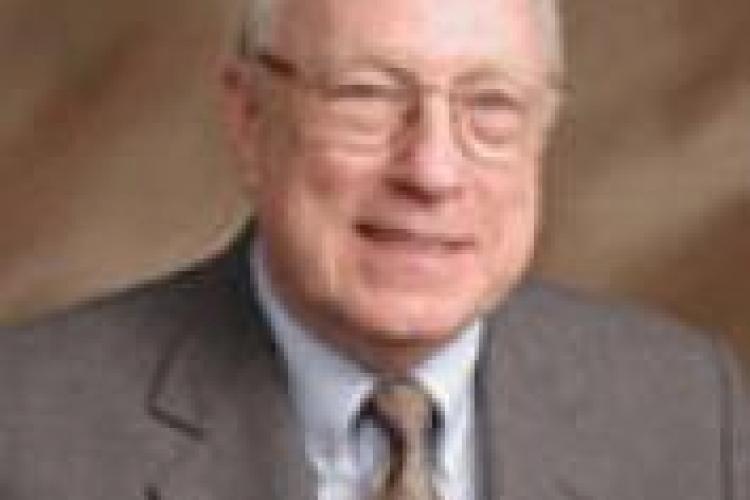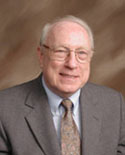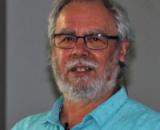Reincarnation's White Crow: Ian Stevenson and Evidence of Past Lives

By John Algeo
Originally printed in the MARCH-APRIL 2006 issue of Quest magazine.
Citation: Algeo, John. "Reincarnation's White Crow: Ian Stevenson and Evidence of Past Lives." Quest 94.2 (MARCH-APRIL 2006):47-51.

The psychologist-philosopher and psychic investigator William James famously remarked that, if you want to prove that not all crows are black, you don't have to look at every crow in the world. You only have to find one white crow. Those who have investigated reincarnation, even when they have been professional psychotherapists, have generally been enthusiastic but amateurish and unscientific in their approach. There is, however, one white crow. His name is Ian Stevenson.
Ian Stevenson
Born on Halloween (make of that what you will) in 1918, Ian Stevenson was a native of Montreal, Quebec. His mother was clearly an important influence on his later life. Of her he said, "My mother had believed strongly in the influence of thoughts on physical well-being, and I may owe to her my initial interest in psychosomatic medicine." (Some of My Journeys'). She is also reported to have had a large library of books on psychic phenomena (Omni 77). It is likely that Stevenson's mother was a Theosophist. He says, "From my early childhood reading I had become familiar with the idea of reincarnation. The concept made sense to me, but I never thought until many years later that there could ever be any evidence to support a belief in it. Certainly the theosophists had offered none." (Some of My Journeys).
Ian Stevenson has had a distinguished, albeit in certain respects unconventional, career. His formal education was at the distinguished old University of St. Andrews in Scotland and at McGill University and its School of Medicine in Montreal. After his medical internship and residence in Montreal and Phoenix, Arizona, he was a Fellow in internal medicine and biochemistry in New Orleans. Then he took training in psychosomatic medicine at Cornell and in Freudian psychoanalysis, which he was later to characterize as "a cone of theory supported by a tiny base of data" and whose originator, Sigmund Freud, he predicted "will one day be considered a figure of fun" (Omni 78). After that, he settled down to professorships of psychiatry at Louisiana State University and the University of Virginia. Thus far, his career had been fairly conventional. But then something happened. He says,
For many years I had a keen interest in extrasensory experiences and kindred phenomena. My dissatisfaction with prevailing theories of human personality led me to extend this interest, and in the 1950s I began to read systematically in the literatures of theosophies and psychical research. [Some of My Journeys in Medicine]
About 1960, early in his career at Virginia, Stevenson began serious study of paranormal phenomena, especially reports of memories of a preceding life and related matters. Such study was certainly unconventional for an academic medical man. A turning point in Stevenson's career was a paper he wrote on The Evidence for Survival from Claimed Memories of Former Incarnations for which he was appropriately awarded the William James Prize by the American Society for Psychical Research. Chester Carlson, the inventor of Xerox, was so impressed by this unusual work that he endowed a chair for Stevenson at the University of Virginia and funded additional research (Omni 78).
Stevenson's pioneering first paper on data suggestive of reincarnation was to be followed by a stream of books reporting further research. Best known and most influential was his first collection of case studies: Twenty Cases Suggestive of Reincarnation (1966). It was followed by four volumes of Cases of the Reincarnation Type from India (1975), Sri Lanka (1977), Lebanon and Turkey (1980), and Thailand and Burma (1983). A succeeding general study was Children Who Remember Previous Lives (1987), and another focused on the West was European Cases of the Reincarnation Type (2003).
In addition to those reincarnational case studies emphasizing memories of a previous life, Stevenson published Reincarnation and Biology, a two-volume technical study, and Where Reincarnation and Biology Intersect, an abridgment for the general reader (1997), both dealing with the possible relationship of birth marks and birth defects to previous lives. He also published two books, Xenoglossy (1974) and Unlearned Language (1984), both on the phenomena of people who appear to know languages they have had no exposure to, perhaps as a carry-over from a prior lifetime. He also did a collection of case studies on Telepathic Impressions (1970). In addition to these book-length studies, Stevenson has published some 150 articles and chapters in scholarly outlets on those and allied subjects.
Anyone who reads these case histories and the extraordinary facts that Stevenson has been able to verify must be impressed by his careful research methods and the accumulated mass of evidence. With regard to reported cases of memories of a previous life, Stevenson's procedure is to get down the facts of the child's (or sometimes adult's) memory as soon as possible, to interview members of the family and neighbors to find out what they know about the events of the memory, to investigate whenever possible the scene of the remembered lifetime including persons from it who are still living, and to verify as many specific memories as possible. Stevenson has investigated thousands of cases of presumed memory. Many of these cases are insufficiently detailed to be convincing, but some are remarkably specific.
A typical but complex example is a young Lebanese boy named Imad, who began to talk about a previous life when he was less than two years old. He mentioned names of people he had known, described property he had owned, told of events that had happened. He sometimes spoke of these matters in his sleep, and sometimes in talking to himself he would wonder how those people he used to know were getting along now. He claimed to have been a member of the Bouhamzy family in the village of Khriby and begged to be taken there.
Imad's father scolded him for telling lies about a former life. But one day a visitor from the village of Khriby came to Imad's town, and the young boy was able to identify him on the street. This event caused Imad's family to take his tales seriously. When Stevenson investigated the case, no contact had yet been made between Imad's present and former families. Although the two villages were only about fifteen miles apart, there was little social or commercial interchange between them.
The life that Imad seems to have remembered was that of Ibrahim Bouhamzy. Imad described Ibrahim's mistress, Jamileh, and was able to name and identify many of Ibrahim's relatives and friends. He described in detail a truck accident that killed one of Ibrahim's cousins. Imad described guns that had belonged to Ibrahim, who was fond of hunting. He described the location of Ibrahim's house, two adjacent wells, the garden under construction at the time of Ibrahim's death, three vehicles Ibrahim owned (a small yellow automobile, a bus, and a truck), and a variety of other details. He was able to repeat Ibrahim's dying words. Also significant is the fact that the child Imad often expressed great joy at being able to walk. Ibrahim died at about the age of twenty-five after spending a year in a sanatorium; he suffered from tuberculosis and was bedridden for the last part of his life.
In trying to piece the information together into a coherent whole, Imad's family drew a number of wrong conclusions, which they attributed to young Imad. Because some of his earliest stories were about a man named Mahmoud, a truck accident in which the victim had both legs broken, and the beautiful woman Jamileh (her name being the first word Imad spoke), Imad's family mistakenly thought he was claiming to be Mahmoud and to have died in the truck accident, as well as to have had Jamileh as his wife. They made other wrong inferences about family relationships among the Bouhamzys and about the events Imad mentioned. Paradoxically, those errors are positive evidence in the case, for they show that Imad's family could not have been the source of the information behind his memories.
Many of the cases that Stevenson investigated share some distinctive features. Typically the preceding life ended prematurely, by accident, violence, or illness. The time between lives was relatively brief. (In the case of Ibrahim-Imad, only nine years elapsed between Ibrahim's death and Imad's birth; and the interval is often less than that.) The two lives were in the same culture, often in the same general geographical area. And, of course, the child remembered the former life. These features reinforce one another.
According to Theosophical writers, when a life is completed normally, the experiences the lifetime was intended to give the individual have been fully realized. Then the individual needs a long period between lives to absorb and internalize the results of those experiences. When the individual returns to birth, it is to gain new experiences, and that return occurs after all the specific memories of the old personality have been discarded. There is thus no conscious link between the old and new personalities.
However, if a life is cut short before the individual has gained from it everything that was in the offing, the customary long period for digesting the past life is not needed. Also the hunger for life which drew the individual into incarnation has not been exhausted, as it would normally be during the course of a completed lifetime. Those two factors may lead to a quick reincarnation because there is nothing to keep the individual in the interim state, and the itch for life demands scratching. The individual is likely to be drawn back to the same neighborhood to the same area and culture with the aim of trying to complete the interrupted experience.
Normally during the long periods between lives, the old emotions, mind sets, and memories are exhausted and discarded, so that when reincarnation eventually occurs, the former personality has been dispersed, and a new personality begins to develop afresh with the new body. In the case of a quick reincarnation, however, there has not been time for that process of wearing out and dispersing of the old to be completed. And so the individual comes back into birth bringing along some fragments of memory, as well as desires and fears, from the former life.
Stevenson's cases, then, would be abnormal ones from the standpoint of the customary pattern of reincarnation. But it is their very abnormality that makes it possible to identify and study them. The normal pattern of reincarnation leaves no easily identifiable traces of a preceding life; the abnormal pattern does.
Possible Explanations for Memories
In investigating his cases, Stevenson considered a variety of possible explanations for the accuracy of the memories reported:
-
Fraud. Deliberate deceit is the least likely explanation in most cases. It would require an elaborate conspiracy between the children, their relatives, neighbors, strangers in other cities, and so on. Furthermore, the presumed conspirators normally had nothing to gain and no other motive. On the contrary, parents were often extremely reluctant to accept such memories.
-
Cryptomnesia. It is possible to believe quite firmly that we have experienced something we have actually read or been told about, but which our mind has converted into a memory. Such hidden (Greek crypto-) memory (mnesia) is also responsible for the phenomenon of unconscious plagiarism: writers may store away a particularly appealing phrase or sentence read somewhere, and then come to think of it as one they themselves composed. Part of what Stevenson investigated was whether anyone in contact with the child knew about the matters the child reported as memory.
-
Telepathy with the living. Possibly the children were reading the minds of living persons who had knowledge of the events and then converting that information into pseudo memories.
-
Retrocognition or precognition. Another possibility is that the child, by some extraordinary faculty, was directly aware of events in the past, before its birth (retrocognition). Or perhaps the child, by an even more extraordinary faculty, was somehow aware of the facts that the investigator would uncover in the future and was predicting them (precognition).
-
Telepathy with the dead. Perhaps the child had entered into telepathic contact with the consciousness of a deceased person and was misperceiving the information thus gained as its own memories.
-
Possession. Perhaps the child was in fact possessed by the spirit of the dead person and the memories reported were the actual memories of that other consciousness who was co-dwelling in the body or who had replaced the original personality. Possibilities 3 through 6 are increasingly improbable from the standpoint of ordinary science and, while not impossible, would require a revolution in scientific thinking just as great as the acceptance of reincarnation as an explanation. Finally, then, Stevenson concluded that the seventh possibility was sometimes the most likely one:
-
Reincarnation. The memories are what they seem to be: recollections of events from a past life of the child. Stevenson never claims that his cases “prove†reincarnation, certainly not in the popular sense of that term. The evidence is hard to come by and hard to evaluate. All Stevenson claims is that these cases suggest reincarnation as an explanation and that there is no more probable explanation available for them. That is a modest claim, but it is still a remarkable one for an academic scientist to make. Since Stevenson's work, it is no longer correct to say that there is no real, solid evidence for reincarnation. That is exactly what he has supplied.
What Does It All Mean?
Stevenson has been notoriously reluctant to draw general conclusions from his formal research, preferring simply to let it stand as evidence. However, in an Omni magazine interview, he was quoted as being a typically free in stating some generalizations. For example, he suggested that some reincarnational memories may be behavioral, rather than imaged, that is, not memories of specific names, places, people, and events, but rather of interests, aptitudes, and phobias. He also asserted that the human personality and such behavioral characteristics cannot be explained solely by genetic inheritance and environmental influences, but require some other factor such as reincarnational memories (78).
In that same interview, Stevenson is quoted as proposing some basic metaphysical propositions. In response to the question, "Do you see in reincarnation a glimpse of a larger purpose," the response was,
Well, yes, I do. My idea of God is that He is evolving. I don't believe in the watchmaker God, the original creator who built the watch and then lets it tick. I believe in a "Self-maker God," who is evolving and experimenting, so are we as parts of Him. Bodies wear out, souls may need periods for rest and reflection. Afterward one may start again with a new body. [110]
Some persons have said it is unfair to be reborn unless you can remember details of a previous life and profitably remember your mistakes. They forget that forgetting is essential to successful living in the present. If every time we walked, we were to remember how we stumbled, we would fall again. [118]
Similarly, in his autobiographical, Some of My Journeys in Medicine, he says, "I am suggesting that instead of a single line of evolution, the one of our physical bodies, we also participate in a second line of evolution, that of our minds or, if you prefer, our souls." And he also says,
There are other means of attaining knowledge besides the scientific method. Art, music, poetry, and other types of literature give us knowledge. I can also believe that in mystical experiences we may have direct access to important truths or, more specifically, to the most important truth of all, which is that we ourselves are part of a Great All. I do not know whether you would call William James, The Varieties of Religious Experience a work of the humanities or one of science. It partakes of the best of both, and for me is one of the greatest books ever written; I know of no better defense of the value of mystical experiences.
Stevenson concludes his autobiographical reminiscences with this evaluation of his own work:
Perhaps my main contribution will be that of making Western persons familiar, not with the idea of reincarnation, it must be one of the oldest ideas in the world, but with evidence tending to support a belief in reincarnation.
Ian Stevenson is thus a white crow among all the blackbirds of both scientists who refuse to contemplate the possibility of reincarnation and of enthusiasts who neglect to examine the subject with appropriate objectivity.
Children Who Remember Previous Lives: A Question of Reincarnation. 2d ed., rev. Jefferson, NC: McFarland, 2001. 1st ed. Charlottesville: University Press of Virginia, 1987.
Telepathic Impressions: A Review and Report of Thirty-five New Cases,. Charlottesville: University Press of Virginia, 1970. Also as Proceedings of the American Society for Psychical Research 29 (June 1970): 198.
Note: The middle part of this article is drawn from the author’s book Reincarnation Explored.

 This Theosophical Encyclopedia contains all the articles of the printed
This Theosophical Encyclopedia contains all the articles of the printed 